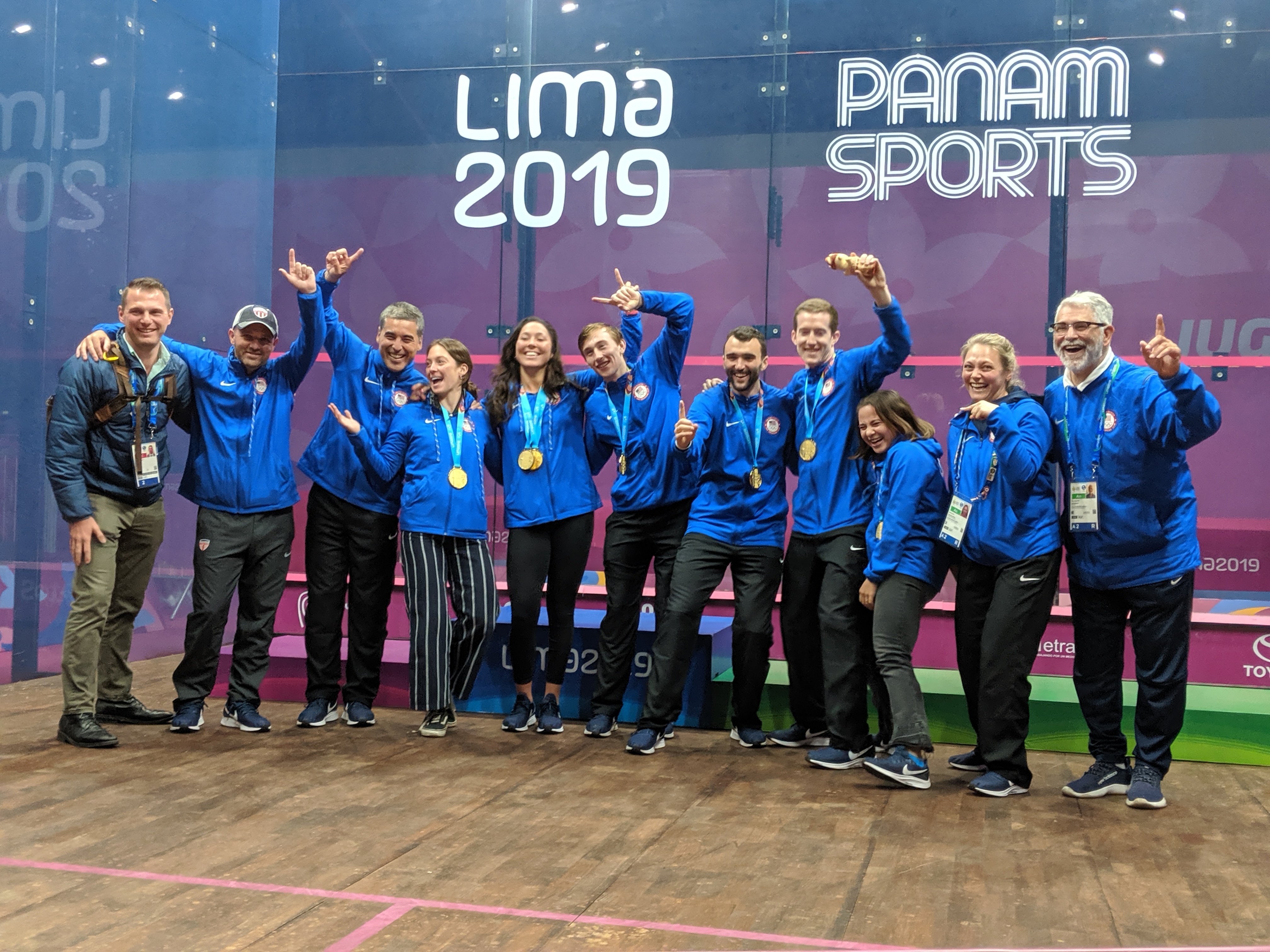Team USA’s squash players standing atop of the podium and singing the “Star-Spangled Banner,” with hands over hearts and with gold medals hanging from their necks.
At the Pan American Games in Lima, Peru in July, this scene became a regular occurrence for six Americans. They summited the highest podium a record five times.
Jugamos Todos. Let’s All Play.
The official motto of the eighteenth edition of the Pan American Games set the stage for nearly 7,000 athletes representing forty-one North and South American nations in Lima, Peru. Since 1951 the Pan Am Games have been held quadrennially in years preceding the summer Olympics. The Lima Games meant a return to the southern hemisphere for the first time since the 2007 Rio Games, following the 2011 in Guadalajara, Mexico, and 2015 in Toronto, Canada. Administered by the Pan American Sports Organization, the Pan Am Games movement is modeled after the Olympics in both organization and tradition. The sporting events were held across more than forty venues in various districts of Lima and neighboring cities, and nearly 10,000 athletes and team officials were housed by nation in a centralized athletes village.
While the Olympics remain the pinnacle for the official twenty-nine summer Olympic sports, the Pan Am Games held varying stakes across its 419 events and thirty-nine sports. For some events such as modern pentathlon, athletes could seal direct qualification for the Tokyo 2020 Olympic Games. For weightlifting, the Pan Am Games are considered a silver-level event for Olympic qualifying, meaning results carried the second-most weight of any qualifying event. Surfing and tennis were considered “wait and see” sports, where Pan Ams results could factor into Olympic qualification depending on results from 2020 professional tour or world championships. For Team USA, nine sports including archery, diving, equestrian eventing and field hockey were considered Olympic quota sports: the athletes who won quota sports in Lima wouldn’t necessarily be the ones competing in Tokyo, however they guaranteed that the respective nation would field athletes for those events.
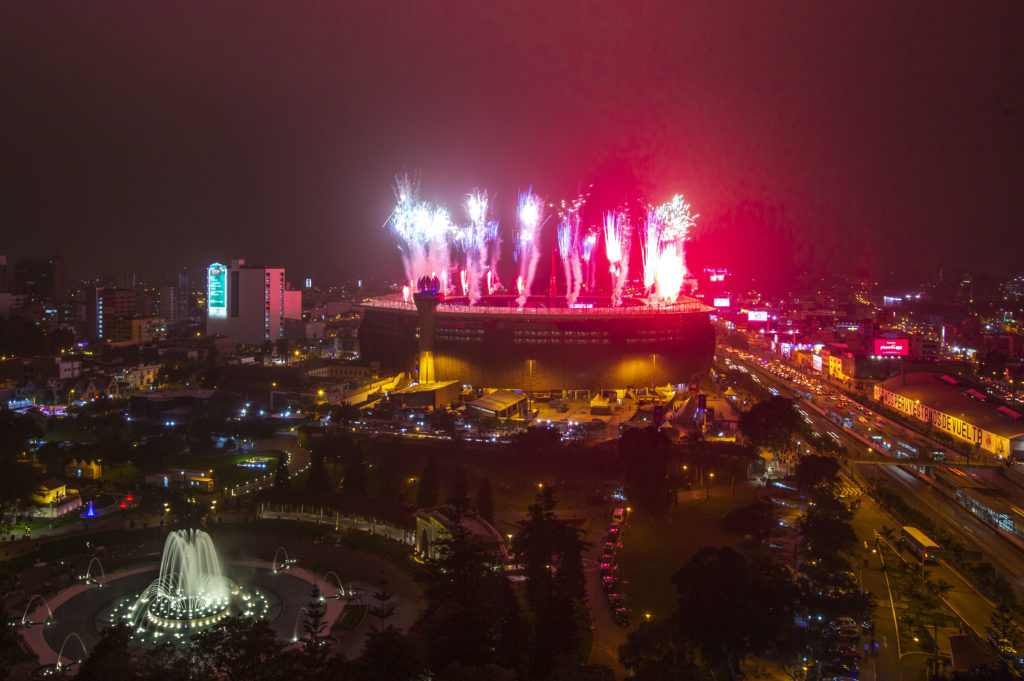
del Peru during the opening ceremony of the
Pan American Games Lima 2019
For squash, however, the Pan American Games are as big as it gets—those moments on the podium are the professional pinnacle for squash players in North, Central and South America, representing the closest thing to Olympic glory for Team USA. Comparable to the Commonwealth Games and Asian Games in stature as squash’s major international multi-sport games, the Pan American Games have served as squash’s de facto Olympics in the Americas since its inclusion into the program in 1995.
While Team USA squash competes annually in Pan Am Championships in the three years leading into the Pan Am Games, the Games are singular in having smaller team size of three men and women, compared to four, and in schedule, spanning just seven days as opposed to eight. The 2019 Games also presented a first with the introduction of a mixed doubles competition, bringing the overall squash competition total to seven gold-medal events: men’s and women’s singles, men’s, women’s and mixed doubles, and men’s and women’s teams.
the Lima Games were represented by an affable mascot, Milco, who was influenced by Cuchimilco sculptures from the Chancay people, a pre-Columbian and pre-Incan culture based on the central coast of Peru. A Pan American Games torch relay began nearly 8,000 feet above sea level in the ancient sanctuary of Machu Picchu and toured through twenty-three cities over the course of twenty-three days, ultimately descending 3,000 feet and igniting the Incan sun-shaped flame during the opening ceremony at the Estadio Nacional del Peru.
The opening ceremony celebrated the diverse culture of both Peru and the Americas. With a flurry of fireworks and fanfare, the performance centered around a colorful representation of Lima’s sacred mountain, Necado Parlacaca, as nearly 50,000 spectators and IOC president Thomas Bach were taken through different stages of Peru’s rich history. The ceremony climaxed with Puerto Rico’s Luis Fonsi, who performed seven songs and ending with his global hit, Despacito, which is the most-viewed Youtube video of all time (6.25 billion views). In Olympic fashion, the forty-one competing nations paraded through the stadium, led by their nation’s standard. Team USA boasted the largest delegation of the games with 643 athletes competing in each of the thirty-nine sports.
Sabrina Sobhy and Andrew Douglas soaked in the once-in-a-life-time experience of the opening ceremony with no morning or afternoon matches the next day. “The opening ceremony was exhilarating,” Sabrina Sobhy said. “We were surrounded in a sea of blue USA tracksuits and although I only knew the squash team, I felt a sense of connection to all of Team USA. I’ve never experienced such a sense of nationality to that extent before and to walk into an arena with hundreds of athletes and spectators feeling like I belong alongside so many amazing athletes is a feeling I will remember for the rest of my life.”
During the parade, there were four notable absences from the American delegation: Olivia Blatchford Clyne, Chris Hanson, Todd Harrity and Amanda Sobhy. They were already amidst their second day of the squash competition and in the early stages of the greatest Team USA international squash performance of all time.
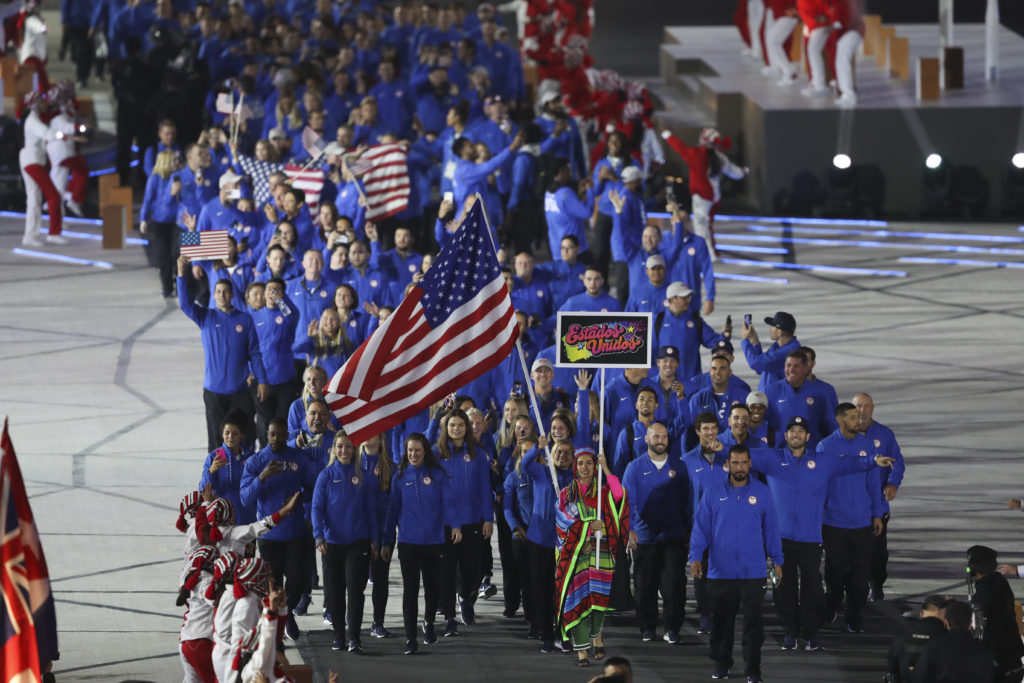
America’s six squash players, while relatively young with an average age of twenty-five, came in with significant experience, including four returning members of the 2015 Toronto Games squad, Blatchford Clyne, Hanson, Harrity and Sobhy. College standouts Sabrina Sobhy, who graduated from Harvard this spring, and Andrew Douglas, a rising junior at Penn, edged difficult competition to round out the squads in what was both of their debuts at the Games. Paul Assaiante, the Ganek Family US Squash Head National Coach, National Coach Thierry Lincou, a former world No. 1, and US Squash Director of National Teams Adam Hamill were at the helm.
Team USA entered the Lima Games with the hope of at least matching what had been a record medal haul of five in Toronto, including a clean sweep of all three women’s gold medals and two men’s bronze medals. (That had been enough for Team USA to top the medal standings for the first time ever at a Pan Am Games.)
Unlike Toronto, which was held in the heat of summer, the southern hemisphere presented cold and damp wintery weather. The squash athletes wouldn’t see the sun until their portion of the competition was over. On court, the conditions favored balls staying up in the corners and dying in the back, rewarding good length and precise play. Over the course of seven days, the pink all glass squash court and softball doubles traditional court constructed at the Villa Deportiva Nacional would serve as a historic stage for both the host nation and Team USA.
Of the sixty squash players competing in Lima, two carried an enormous weight of expectation: Diego Elias and Amanda Sobhy. In February 2013, when the Pan American Games were officially awarded to Lima, Elias was fifteen years old and living in the city. His squash career was just starting to show real signs of promise under guidance of his father, Jose Manuel, a former Peruvian national champion and national coach. Six months prior to the announcement, he won his first international title—the Pan American Junior U19 Championship; in the months after the announcement, he won the British Junior Open U17, South American Juniors U19, Pan American Juniors U19 and U.S. Junior Open U19 titles. (Elias’ rise and U.S. Junior Open win were chronicled in the January 2014 issue of Squash Magazine.) Elias made his mark on the global stage in 2014 when at age seventeen he became the first South American player to win the World Juniors, which he successfully defended in 2015. Making his Pan Am Games debut at Toronto 2015 at eighteen years old, Elias exceeded his 3/4 seeding by reaching the final, upsetting Mexico’s two seed Cesar Salazar in the semis before falling against Colombia’s top seed Miguel Angel Rodriguez in an eighty-eight-minute final.
At twenty-two years old, Elias entered the Lima Games ranked a career high world No. 8, narrowly earning him the top seed ahead of Rodriguez, world No. 9. In front of a vocal capacity crowd, Elias and Rodriguez contested a fiery, passionate final worthy of the Olympics. After four games and sixty-six minutes, Elias dethroned Rodriguez—his only win over the “Colombian Cannonball” in their seventh career encounter. “It feels amazing to have the support of the fans in your own country,” Elias said afterwards. “I’m still processing it. It feels so good. I’m really happy. I’ve been working really hard to achieve this. I’m grateful to my whole team, especially my dad, who has supported me since the beginning.”
Elias’ gold medal transcended the global squash community. The next day, he graced the front page of Peru’s national newspapers with the caption “cry of a nation” accompanying his celebratory image. Martin Vizcarra, Peru’s president, hosted Elias and other Peruvian medalists at the Palacio de Gobierno. Elias’ gold medal was not only the first medal earned by Team Peru, but it was one of just eleven gold medals won by the host nation.
Amanda Sobhy’s career has been measured in gold. Four years ago, the New York southpaw made history in Toronto by becoming the first male or female squash player to win three gold medals during the same Pan Am Games. In Lima, Sobhy, as the highest ranked player in the women’s singles field, was poised to achieve the feat again. “Having the experience of winning three gold medals in Toronto really helped me prepare for Lima,” Sobhy said. “I put a lot of pressure on myself, but there was also a lot of pressure on me in general to repeat. The weather outside was cold and cloudy, and I just felt like there was this gray cloud of pressure looming over me that wouldn’t dissipate until the event was over.”
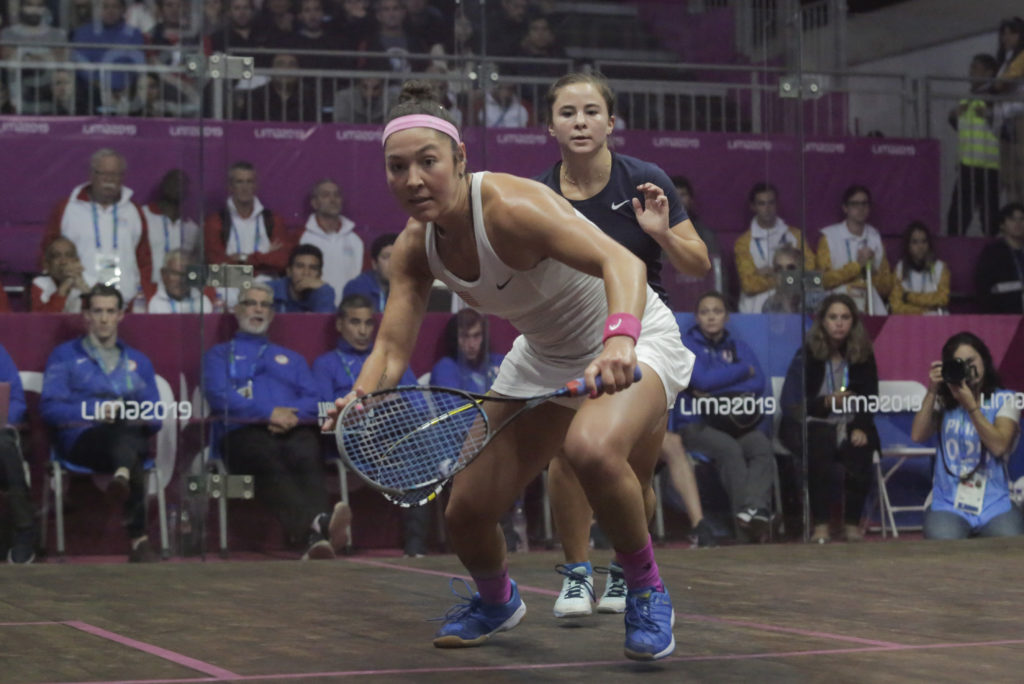
and Olivia Blatchford Clyne in the
women’s singles gold medal match
The competition format in Lima presented unprecedented challenges. Even with the Pan Am Games debut of a mixed doubles competition—which added a seventh tournament to the schedule—all the squash events still took place within seven days. In Toronto, the earliest match times were at noon; in Lima, matches took place as early as 8am and ended as late as midnight. As a result, Sobhy spent more time on court than any other squash player in Lima with ten matches over the course of the week. At times she played as many as three matches in a single day.
This condensed schedule meant recovery and physical management were essential. Crucially, the USOPC designated team physio, Shelby Hoppis, became one of the most important team roles. “Shelby was critical to our recovery with so many matches in such little time,” Sobhy said. “The recovery and turn around aspect was key. We had to closely manage our time and energy, and not mess around in terms of expending extra energy when you need to conserve it.”
While Team USA marched out during the opening ceremonies, Sobhy and Blatchford Clyne remained in the athletes village, preparing for their respective 9am semifinals the next morning against 3/4-seeded Canadians Hollie Naughton and Samantha Cornett. Their preparation paid off as both Americans progressed in three games to set up a repeat of the Toronto gold medal match. Coaches Assaiante and Lincou decided that there shouldn’t be any coaching in the all-American final out of fairness to both players.
“The individuals were the most stressful for me,” Sobhy said. “Hollie and Liv are two of my best friends and I had to play them on the same day. There was a lot of pressure on me to perform and they were free to play without pressure as the lower seeds. Liv and I spent the few hours before the final together going through our rituals right next to each other knowing that soon we were going to play each other in one of the biggest matches of our careers.”
Blatchford Clyne took an early advantage in the final by winning the first game 11-7—the only game Sobhy dropped the entire week—before Sobhy bounced back to successfully defend her gold medal 7-11, 11-5, 11-7, 11-8. “Liv played really well,” Sobhy said of her teammate. “I was happy with how I was able to handle all of the stress and pressure. I had to come back without by myself with no coaching after losing the first game. To win that first gold was a massive sigh of relief and I felt more relaxed for the rest of the tournament.”
After topping the singles podium together, Sobhy and Blatchford Clyne prepared for their third match of the day that evening—doubles semifinals. Blatchford Clyne & Andrew Douglas would falter against Mexico’s Alfredo Avila & Diana Garcia, thus collecting bronze in the inaugural mixed doubles. The top-seeded Sobhy sisters would brush aside Chile’s 3/4 seeds 11-5, 11-3 to set up the chance of another gold medal in women’s doubles the next day.
Chemistry and communication were the keys to Team USA’s brace of doubles gold medals. What—if anything—forms a stronger sense of understanding and communication than sisterhood? The Sobhy sisters are no strangers to the hardball doubles courts, whether through winning events on the WSDA tour as Amanda has in seasons past or winning Mixed Doubles national titles as Sabrina had this spring.
Softball doubles is a different beast, however. Team USA’s only regular exposure to softball doubles is on the Pan American stage. Per the namesake, a softball is used, and the dimensions vary with softball courts being shorter in length and wider than a hardball doubles court. The 2018 Pan American Championships in the Cayman Islands provided the Sobhy sisters with a training ground for softball doubles—they earned gold medals there, helping give them the top seed in Lima.
Sabrina’s first foray into Pan Am Games competition was on the doubles court with only two players from each country competing in the singles draw. Similar to Amanda’s Pan Am Games debut four years ago, Sabrina’s came just months after completing a successful collegiate career at Harvard, and just before entering her first season as a full-time touring squash professional.
Amanda and Sabrina had contrasting tournaments leading into the doubles competition. The women’s doubles semifinals was Amanda’s third match of the day while it was Sabrina’s second of the tournament and first of the day. “It was important for me to understand Amanda’s disposition before stepping on court; to know what she needed to hear in regards to her mental state to play her best on court,” Sabrina said. “We had this unspoken notion that regardless of the situation, we could rely on each other to step up to the plate and be present.”
Sabrina knew that Amanda would need both mental and physical support, sometimes meaning she would be expected to cover more of the court if Amanda’s legs began to feel heavy. That would be the case in the gold medal match against Canada’s Cornett and Danielle Letourneau, the day after Amanda played three matches and won singles gold. With softball doubles scoring being best of three games with no tie break at 10-all, every point mattered. The Americans started slowly in the final going down 5-1 and Canada earning three game balls up 10-8.
“I was very slow to start, I was definitely feeling the effects of the three matches the previous day,” Amanda said. “I was sore and mentally I was coming down from all of the adrenaline, so it was tough to get myself going. At 10-8 down, I knew how critical the first game was. I told Beans (Sabrina) that she needed to take a lot of the balls, I had to push her physically because she was fresh and could cover a lot of the court.”
The Sobhy’s won the next three points to take the first game 11-10, and clinched the gold medal 11-8 in the second, competing a perfect run of three 2-0 victories. A gold medal for family and country.
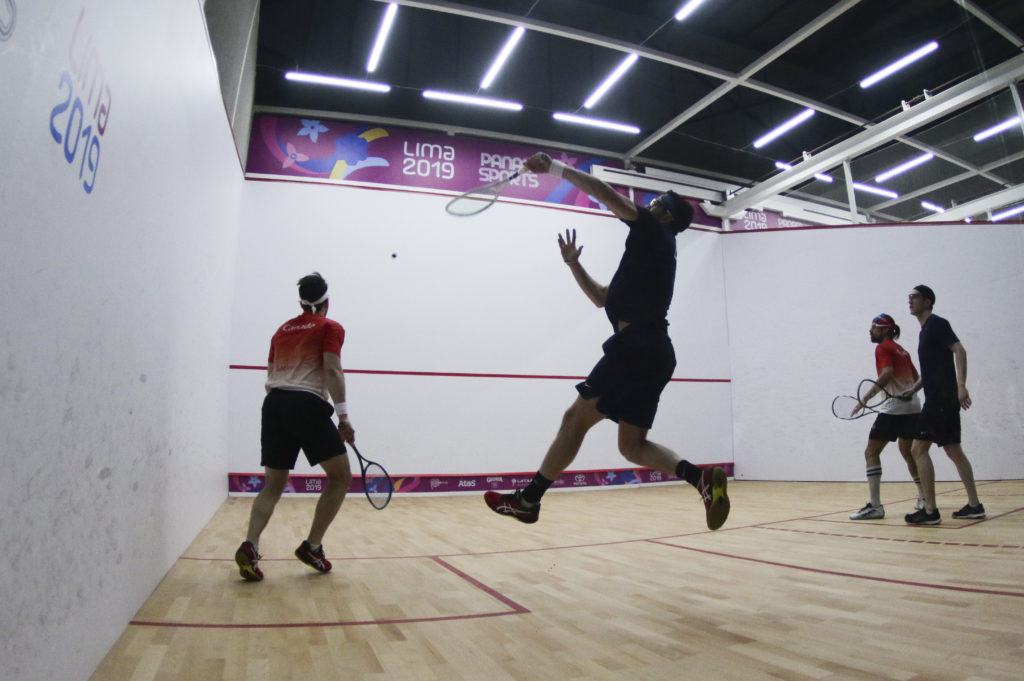
For the men, it was also a difficult path to the podium. In early July, Chris Hanson & Todd Harrity honed their softball doubles partnership in Philadelphia with Commonwealth Games softball doubles veterans John White and Alan Clyne. While their doubles partnership was new, their friendship dated back to when they were twelve years old playing juniors together. Hanson was set for his second Pan Am Games doubles appearance after earning a bronze medal in Toronto, while Harrity was set for his doubles debut. “When we were getting used to playing with each other and working on our chemistry, we tried to balance being serious with enjoying a new game,” Hanson said. “We took that mindset into Lima. We just felt that we were good together, communicated well and wanted to stay in the moment and enjoy it.”
Seeded 3/4, Hanson & Harrity’s first test came in the semifinals against two seeds and hosts, Peru’s Elias & Alonso Escudero. In spite of a home crowd that hurled boos towards the Americans, Hanson & Harrity stuck to their game plan and consigned the hosts to bronze medals with an 11-8, 11-8 win. In the top half of the draw, Canada’s Shawn Delierre & Nick Sachvie upset Mexico’s top-seeded Salazar brother partnership in three games. Despite a modest 5/8 seeding, Canada entered the final hungry for their first men’s doubles gold medal having fallen short in the Toronto final.
Canada sped to a 7-0 lead in the final, at which point Hanson & Harrity came together in the back of the court and regrouped. “It was that moment when in your head you’re thinking ‘I’m ok with a silver medal and this was a great run,’” Hanson said. “But we had to change that to ‘come on, let’s figure this out and dig deep.’ I looked over to Todd and he didn’t want to go home with a silver medal, and I certainly didn’t. We said let’s just take it one point at a time.”
The Americans built some momentum winning six of the next ten points as the first game went to the Canadians 11-6. Harrity & Hanson turned the match on its head in the second, Harrity became looser, hitting his shots and finding his length. The third game was tighter, with the U.S. earning three match balls up 10-8. In the final rally, Harrity fired off a rolling cross-court nick to earn Team USA’s first Pan American Games men’s gold medal in any event.
“We were playing a really fast rally and the ball suddenly came within my forehand volley area, so I just smacked it and it ended up being a perfect, cross-court nick,” Harrity said. “Chris shouted ‘YES!’ and the rest of the team and coaches all jumped from their seats. Honestly, I was just stunned for a moment. I couldn’t believe I had just somehow ended the match with a rolling nick. But then is set in, we had won our first gold medal. We were over the moon, it was absolutely amazing.”
Earlier that day, the men’s and women’s teams played their first pool play match. After the doubles finals, the group returned to the athletes’ village to recover and turn in for the night. Douglas, Harrity’s roommate, plugged in his phone. It blew the socket, losing power in their room and turning the plug black. Harrity then jumped in the shower only to find that the hot water wasn’t working. It was the only thing that would go wrong for the rest of the tournament.
As defending gold medalists, the U.S. women’s team had a target on their backs in Lima. Amanda Sobhy and Blatchford Clyne, the only top-twenty-ranked women in the competition and Toronto veterans, had already proven themselves in the singles competition. Sabrina Sobhy rounded out the team in her first appearance on a singles court in Lima, capable and prepared for any decisive rubber match. “The good part about the team event is that you have teammates who are there for you and it doesn’t all ride on one person,” Amanda Sobhy said. “I went in there and tried to enjoy myself knowing that whatever happened my teammates and coaches were there to support me.”
The younger Sobhy sister would only be called upon in pool play however, where the U.S. breezed past Chile, Argentina and Mexico. As the U.S. entered the knock out rounds on top of the draw, a 1-2-3 playing order was established by the organizers, meaning Amanda Sobhy and Blatchford Clyne would be positioned to clinch each match for the U.S. with Sabrina on deck in the case of a rubber match.
A swift quarterfinal win against Peru set up a dramatic day, July 31, with the semifinals at 9am in the morning and finals that afternoon. For the second time in three days, the U.S. topped 3/4 seeds Mexico to set up a rematch of the Toronto gold medal final against two seeds Canada. The playing order set up rematches of the singles semifinals between Amanda Sobhy and Naughton, and Blatchford Clyne and Cornett. “Nothing will compare to that feeling of a gold medal final,” Blatchford Clyne said. “I remember thinking that I wanted to leave everything out there on court, and that if I could I would be really happy. I would be able sit down and feel satisfied that I gave it absolutely everything.”
As she did in the singles semifinal, Amanda Sobhy dispatched world No. 29 Naughton 11-9, 11-8, 11-7, earning the U.S. a 1-0 lead. The women’s match of the tournament ensued between Cornett and Blatchford Clyne. The first game was a battle, Blatchford Clyne held multiple game balls but Cornett levelled the score at 10-all, until Blatchford Clyne closed out the game 15-13. A manic second game saw Cornett earn a 9-4 lead, at which point Blatchford Clyne rattled off six straight points to earn a game ball 10-9. “Little did I know I was about to start a whole new game right there,” Blatchford Clyne said. “It was an interesting energy in that game. I felt like every time she had game ball, I played my best squash. Sam was using the court and cold conditions very well. It kept going back and forth and we kept fist pumping and getting into it. Towards the end, I thought ‘this is going to be hard, but if you can push you can get through this.”
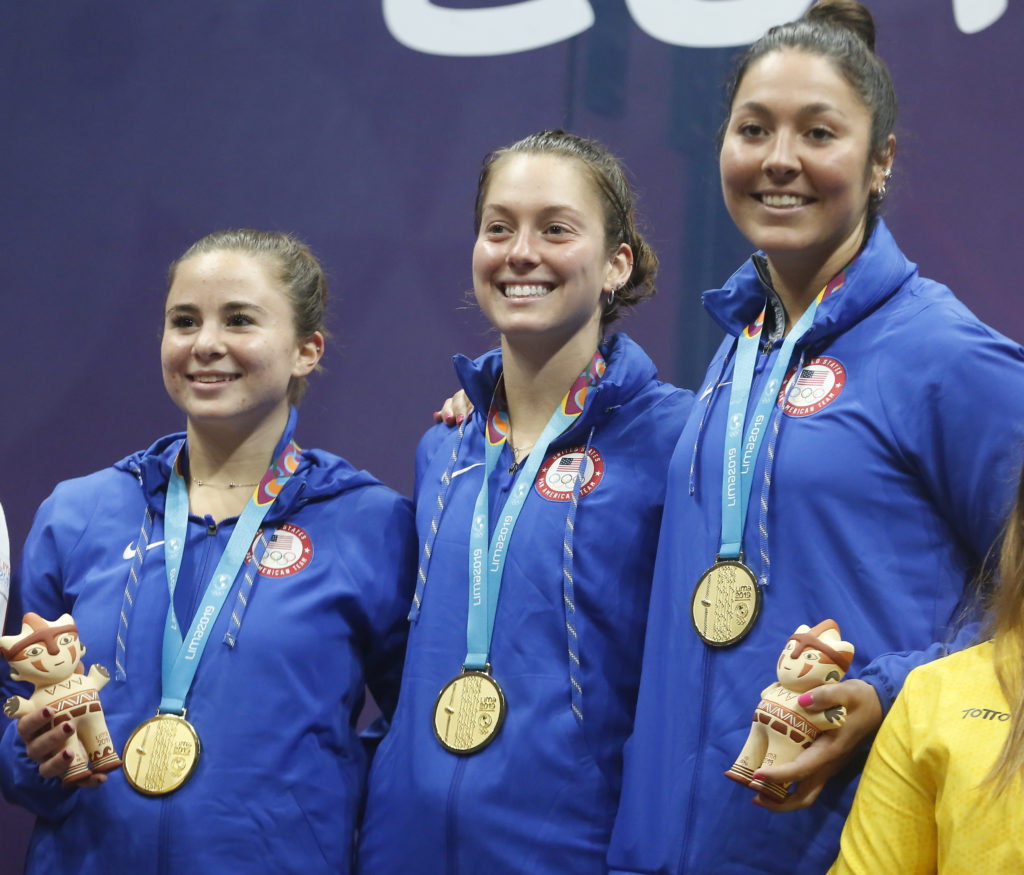
the U.S. women’s team topped the podium,
(l-r): Olivia Blatchford Clyne, Sabrina Sobhy,
Amanda Sobhy
Blatchford Clyne closed out the marathon game 21-19, putting the U.S. one game away from a gold medal. “I felt so much energy and faith from the team after that second game,” Blatchford Clyne said. “Every time things felt tough, I thought to myself ‘I have my support, I can do this.’ I remember on match point my final swing and fist pump morphed into one. I walked out of there, and I remember thinking that I was so tired, not even physically, but just mentally. I was so relieved. That was totally one of the best moments of my career. Big wins for your country—how can they not be at the top of your accomplishments?”
For the second straight Pan Am Games, Team USA’s women established themselves as the best in the Americas with a gold medal clean sweep. The women have now equaled Canada’s all-time total of three women’s team gold medals, having first won gold in 2003 with Latasha Khan, Louisa Hall and Meredeth Quick.
“For us, we were the hunted, and it’s an honor to be the hunted,” Blatchford Clyne said. “It’s hard to win when you have a target on your back and it’s a great achievement to think ‘OK, we got the job done.’ But the men’s team, that was something special.”
Paul Assaiante, the Ganek Family US Squash Head National Coach, knew that there was a very good chance that the men’s team results could be determined in the No. 3 position, by twenty-year-old Douglas. At a team lunch earlier in the week, he told the rising Penn junior, “Andrew, I don’t know when, but at some point this week it’s all going to come down to you.”
“I hope so, Coach,” Douglas replied.
“I was in a strange position,” Douglas said after the event. “I knew that I would either not play my match because it was a dead rubber, or my match would be the decider, so I was pretty on edge.”
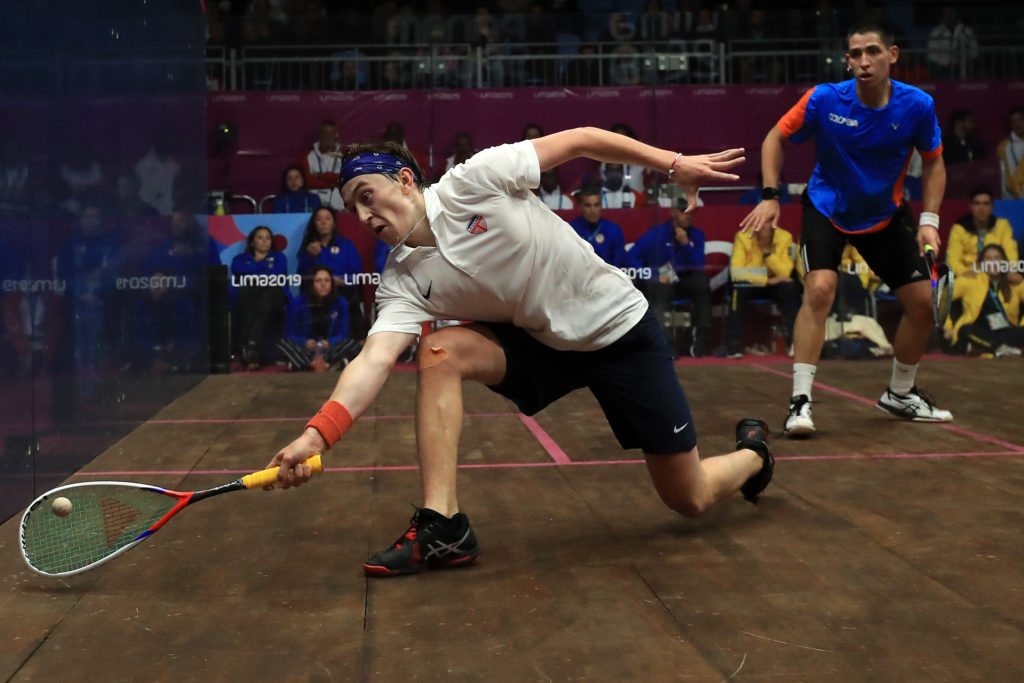
As with the women’s team tournament, the four men’s team pools played out according to seeding. A quarterfinal win against Brazil set up a semifinal against top-seeded Mexico on the morning of July 31. Since 1995, the U.S. team had never beaten Mexico at the Pan Am Games, nor had they ever progressed past the semifinals—the stage at which their run ended in the last two games. “The way we talked about it amongst the team was that the semifinal was our final,” Hanson said. “We couldn’t even think about there being a final that night. We had nothing to lose, we had to stay in the moment and focus.”
Mexico started the semifinal on the front foot as world No. 21 Cesar Salazar defeated Harrity in the No. 1 position, 11-8, 11-8, 11-7—his third career victory against the American on the Pan American stage. The result set the stage for Salazar’s twin brother, Arturo, who could seal passage to the final with a potential sixth career win in six match ups with Hanson. “I had never beaten Arturo in my whole career and I worked for weeks going over in my head what would happen when I would come up against him and how it would be different this time,” Hanson said. Hanson’s mental preparation paid off on court, as he fought through ups and downs 12-10, 4-11, 11-7, 14-12.
On paper, the decisive match in the No. 3 position should have been a one-sided affair between former world No. 35 Alfredo Avila and Douglas, talented yet unestablished on the global stage. “I was just so happy to get on court and be on that big stage, and I found some of my best squash because of it,” Douglas said. Avila led 2-1 after a close three games 11-7, 7-11, 11-8, at which point Douglas shifted into another gear, storming through the fourth and fifth games 11-4, 11-4 to send the U.S. men to their first gold medal match ever.
The final against second-seeded Colombia opened with a similar cadence as the semifinal. Harrity once again took on a leading player, world No. 9 Miguel Angel Rodriguez. Despite Harrity acquitting himself well, Colombia took the match and 1-0 lead, 12-10, 10-12, 11-7, 11-7. Once again, Hanson stepped up to provide a lifeline for the U.S., this time with a decisive victory over Trinity graduate Juan Vargas, 11-5, 11-9, 11-7.
Once again Douglas entered the court with the team result on the line. Unexpectedly, he was the favorite against Andres Herrera—a twenty-three-year-old who hadn’t played a professional event since 2017. “I felt the pressure in the final,” Douglas said. “I knew that I was actually expected to win this match, but the pressure made it tough to play my best, so I had to dig in and just focus on the mental side.”
“I was unbelievably nervous watching Andrew,” Hanson admitted. “After he dropped the second game I had to walk away for a little and I was pacing on the back courts. I eventually gathered myself and got back out there to support him. He did what he had to do in the next two games, I didn’t doubt him for a second.”
Cometh the hour, cometh the man. After splitting the first two games, Douglas made history by winning the match 11-4, 6-11, 11-6, 11-8. The U.S. had clinched the gold medal.
“Those were the two biggest wins of my career,” Douglas said. “The feelings of that day will undoubtedly never leave me. When we were on the podium it felt like it was a win for all of us, including the incredible group of people that supported us. Having Coach Assaiante, Titi, Adam, Shelby, Dent and USOPC support was such an advantage and luxury that we don’t get to experience often, and we were all incredibly grateful by the end of it.”
The double team gold medals cemented Team USA’s position atop of the squash medal standings in Peru, the second straight Pan Am Games where the U.S. led the field. Moreover, the men’s team gold provided the U.S. with the most Pan Am Games squash gold medals of all time, one ahead of Canada.
“I’ve represented the U.S. many times but have never been a part of a team that has won something of that scale,” Harrity said. “It’s amazing how much a good team dynamic can impact performance. Lima is the proudest moment of my career thus far. Playing for your country is an honor, you’re not just playing for yourself, but something much greater.”
“I don’t have words to describe it,” Amanda Sobhy said. “It was huge for Team USA and US Squash. I will cherish that day and feeling forever.”
“There was something about being on top of the podium alongside teammates both times,” Hanson said. “It just seemed like the entire group knew how big of a moment this was together. It was much more satisfying that any sort of individual accomplishment—to pull this together and do it as a team.”


